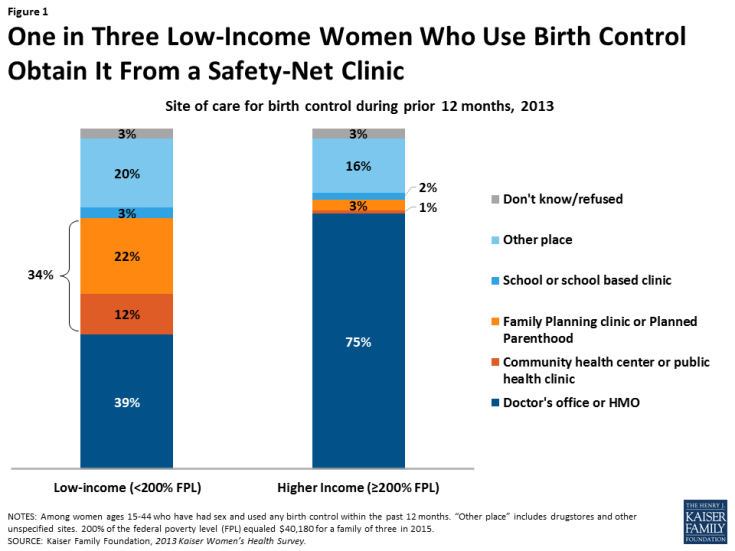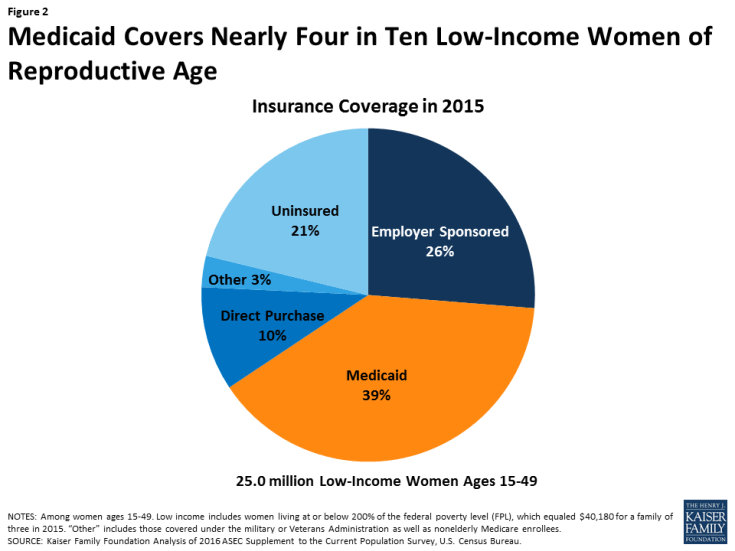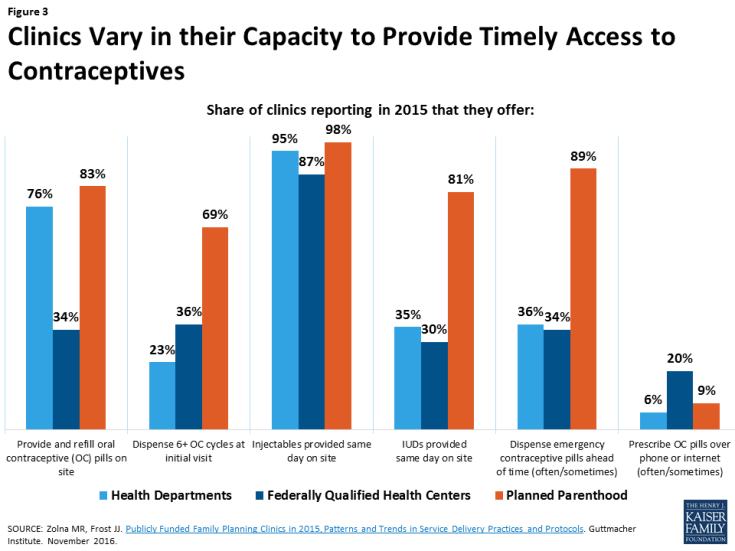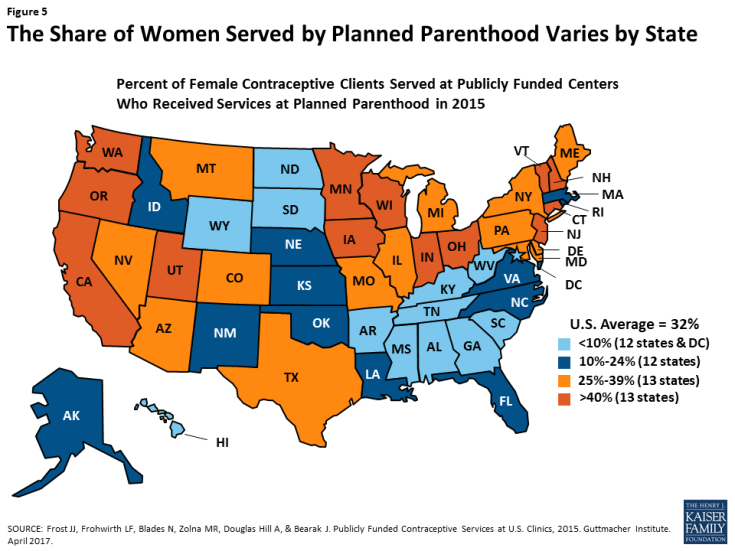Financing Family Planning Services for Low-income Women: The Role of Public Programs – Issue Brief – 9028
For more than 50 years, a network of public programs and providers have assisted millions of low-income women of childbearing age in the U.S. to obtain sexual and reproductive health services. Medicaid, the Title X Family Planning Program, and Section 330 of the Public Health Service Act (PHSA) are the leading sources of federal funding for the over 10,000 safety-net clinics across the country that provide reproductive health services to low-income women, men, and teens. The Trump administration and the Republican leadership of the 115th Congress have proposed to block federal Medicaid funds from going to Planned Parenthood, a safety-net provider that delivers a wide range of reproductive health services and cancer screenings to more than 2.5 million women. In addition, the Trump administration’s FY 2018 budget proposal would reduce by 18% discretionary federal support for the Department of Health and Human Services, the agency that funds Title X and community health centers.
Changes to these programs and funding to the clinics that provide family planning services could limit the availability of contraceptive services, STI screenings and treatment, and preventive cancer screenings, along with other primary care services to low-income women. Poor women are more likely to experience an unintended pregnancy, have an abortion, contract a sexually transmitted infection (STI) and have less access to care than higher income women.1,2 In 2015, approximately one-third (25 million) of reproductive-age women lived in households that earned less than 200% of the federal poverty level ($40,180 for a family of three). For low-income women, clinic-based providers are important sources of family planning services. One in three low-income women reported that they obtained birth control from a family planning clinic such as Planned Parenthood or another health center or public health clinic (Figure 1). These providers are highly reliant on Medicaid, Title X, and the 330 program to be reimbursed for and to support care delivered to low-income individuals for family planning and other basic health services important to women. This brief reviews the role of these public programs and providers in financing care and enabling access to family planning services and addresses the potential impact of actions taken by President Trump and Congress to block federal funds from Planned Parenthood and other entities that provide abortion.
Medicaid is a Key Source of Coverage for Low-Income Women and Central to Federal and State Efforts to Support and Finance Family Planning
Medicaid, a jointly operated and funded federal/state program, is the dominant form of coverage that covers nearly four in ten (39%) low-income women of reproductive age (Figure 2). Across the nation, the share of low-income reproductive-age women enrolled in Medicaid varies considerably by state. These differences are shaped by state choices about Medicaid eligibility policies and poverty rates. Coverage rates range from a high of 64% in Maine to a low of 21% in Kansas and Texas (Appendix Table 1). In 2014, 19.1 million reproductive-age women were enrolled in the program. For these women, Medicaid not only plays a crucial role offsetting the costs of family planning services and pregnancy-related care, but also provides them with comprehensive affordable coverage to meet the full range of their health care needs.
Medicaid is the leading source of public financing for family planning services, accounting for 75% of all public funds spent on contraceptive services and supplies in 2015.3 Federal statute stipulates that family planning is a “mandatory” benefit that states must cover under Medicaid. States, however, have considerable discretion in specifying the services and supplies that are included in the program. Most states make the full range of FDA approved contraceptives available to women, and nearly all cover counseling on STIs and HIV as well as screening for cervical cancer.4
There are numerous other federal requirements that shape family planning policy under Medicaid:
- The federal government pays 90% of all family planning services and supplies, and states pay 10%. This is considerably higher than the federal match that states receive for most other services, which ranges from 50% to 78%, depending on the state.
- Federal law prohibits cost sharing for any family planning (and pregnancy-related) services.
- Medicaid beneficiaries have “freedom of choice” to obtain family planning services from any provider participating in the program, even if the beneficiary is enrolled in a managed care plan and the provider is outside of the plan’s network.5
- The Hyde Amendment prohibits any federal dollars, including Medicaid reimbursements, from being used to pay for abortions except in cases of rape, incest or life endangerment of the woman.6 Clinics, including some Planned Parenthood centers, which provide both family planning and abortion services, cannot be reimbursed with federal Medicaid dollars for abortions, but they can be paid for all other non-abortion care including contraceptives, cancer screenings, and STI testing and treatment.
- States must allow “any willing provider” to participate in the Medicaid program unless there is “evidence of fraud or criminal action, material non-compliance with relevant requirements, or material issues concerning the fitness of the provider to perform covered services or appropriately bill for them.”7 While this provision is not specific to family planning, the policy means that states cannot bar providers from the program simply because they provide abortion services.
- States may opt to establish limited scope programs through Medicaid Section 1115 Research and Demonstration Waivers or through State Plan Amendments (SPAs) to provide family planning services to individuals who do not qualify for full-scope Medicaid. Today, more than half of states have established such programs.
Title X Funds Support Thousands of Clinics That Provide Family Planning Services to Low-Income Women
The Title X National Family Planning Program, a federal block grant administered by the HHS Office of Population Affairs (OPA), is the only federal program specifically dedicated to supporting the delivery of family planning care. In 2015, 66% of clients seen at Title X clinics had family incomes at or below the poverty level, 35% were covered by Medicaid or another public program, and nearly half (48%) were uninsured.8
The program funds agencies in each state to allocate federal dollars to safety-net clinics to provide family planning services to low-income, uninsured, and underserved clients. More than 4,000 clinics nationwide received Title X funding in 2015, including specialized family planning clinics such as Planned Parenthood centers, community health centers, health departments, as well as school-based, faith-based, and other private nonprofits.9
Title X clinics must serve low-income populations at low or no cost, provide clients with a broad range of contraceptive methods as recommended by the national Quality Family Planning Guidelines (QFP), and ensure that the services are voluntary and confidential.10 In addition to providing clinics with funds to cover the direct costs of family planning services, Title X funds enable clinics to pay for infrastructure such as rent, utilities, health information technology, staff salaries, as well as patient and community education about family planning and sexual health issues. Title X clinics are also eligible to obtain discounted prescription contraceptives and devices through the federal 340B program. No other federal program makes funds available to support clinic infrastructure needs for family planning.
Signed into law by President Nixon in 1970, the Title X program is currently funded at $285 million. The program budget, however, has not kept pace with medical price inflation over time. In the past decade, the program has experienced significant financial cutbacks and some Congressional leaders have questioned the need to continue to fund the program. Revenue to Title X clinics is a mix of direct grant money, Medicaid and private insurance reimbursement, and other government funds. Title X clinics received 19% of their revenue from the Title X grant, while Medicaid reimbursement accounted for 40% of revenue in 2015.11
While Many Clinics Offer Family Planning Services, the Range and Volume of Family Planning Services They Provide Varies Considerably
Under Section 330 of the PHSA, the Health Resources and Services Administration (HRSA) provides grants to health centers whose main focus is providing primary and preventive care to underserved and vulnerable populations. These clinics, called Federally Qualified Health Centers (FQHCs), are required to provide “voluntary family planning” services along with a wide range of health care services. Although it is not specifically defined in FQHC guidelines, voluntary family planning services can include preconception care, screening and treatment of STIs, and contraception.12 A survey of FQHCs found that virtually all reported they provided at least one method of contraception at one or more of their clinical sites, and 87% reported that their largest primary care site prescribed oral contraceptives and one additional method of contraception.13 A 2015 Guttmacher survey found that FQHCs that also receive Title X funding were more likely to offer a wider range of contraceptive methods compared to FQHCs that did not.14
However, research has documented differences between clinic types in their ability to offer direct access to many of the most effective contraceptive methods (Figure 3). For example, about eight in ten Planned Parenthood clinics (83%) and three-quarters of health department clinics (76%) can provide initial supply and refills of oral contraceptives on site, compared to one-third (34%) of FQHCs. Similarly, about eight in ten Planned Parenthood clinics report they can provide IUDs the same day (81%) and dispense emergency contraception ahead of time (89%), practices which are far less common at health departments and FQHCs.15
FQHCs are paid using the Prospective Payment System (PPS), which calculates reimbursements based on geographic location and a pre-determined, fixed amount per patient visit based on cost, regardless of the services provided.16 This payment methodology results in a higher reimbursement than that paid to other clinics and providers under Medicaid. FQHCs must have a sliding fee scale for patients with incomes below 200% FPL and offer services to all patients regardless of their ability to pay.17 Of those served in 2015, 71% lived at or below the poverty line, 24% were uninsured, and 49% were on Medicaid or CHIP.18,19 Similar to Title X clinics, FQHC funding comes largely from Medicaid payments, which made up 42% of revenue in 2015, followed by Section 330 grants (20%) and state, local, and private grants (14%).20
Blocking Federal Medicaid Reimbursement to Planned Parenthood Could Limit Access to Family Planning For Many Women and Potentially Increase Unintended Pregnancy Rates
President Trump and many Congressional Republicans have stated their intent to ban federal funds from going to Planned Parenthood clinics. They have already reversed an Obama era regulation that would have prevented states from blocking Title X funds from going to Planned Parenthood and other clinics that provide abortion using other funds. The American Health Care Act (AHCA), the House Republicans’ bill to replace the Affordable Care Act, includes a provision that would ban federal Medicaid funding of Planned Parenthood for one year. If the bill becomes law, this would upend Medicaid’s “any willing provider” requirement and be a major financial hit to one of the primary safety-net providers for over 2 million low-income women. Proponents of defunding Planned Parenthood object to providing federal funds to an organization that provides abortion services, however, the Hyde Amendment already clearly prohibits federal funds, including Medicaid and Title X, from being used to pay for most abortions. The Congressional Budget Office (CBO) analysis of the AHCA estimated that while the provision would result in a net decrease in direct federal spending, it would also cut off contraceptive access to women in some communities, resulting in a rise in unintended pregnancies covered by Medicaid.21
A common theme among proposals to block Planned Parenthood from the Medicaid program is the redirection of funds to other providers, such as community health centers (CHCs), with the expectation that other clinics could meet the needs of those formerly served by Planned Parenthood. The AHCA provides additional funds to CHCs, presumably to support an alternative provider to Planned Parenthood, but there are no specifics in the bill that would require the health centers to use these funds to provide services to women.22 Additionally, CHCs may not have the capacity to fill the void if Planned Parenthood were excluded as a Medicaid provider. Despite comprising just 6% of clinics that provide family planning services, Planned Parenthood served approximately one-third (32%) of women seeking contraceptives at safety-net clinics in 2015. In contrast, while there are considerably more FQHCs (representing 54% of safety-net clinics), they served roughly the same share (30%) of women seeking contraceptive care as Planned Parenthood (Figure 4). FQHCs may not be able to meet additional demands that would be placed on them to provide the full range of family planning services, particularly if they face budgetary limitations from other policy changes such as the repeal of the ACA or cuts to federal discretionary programs.23
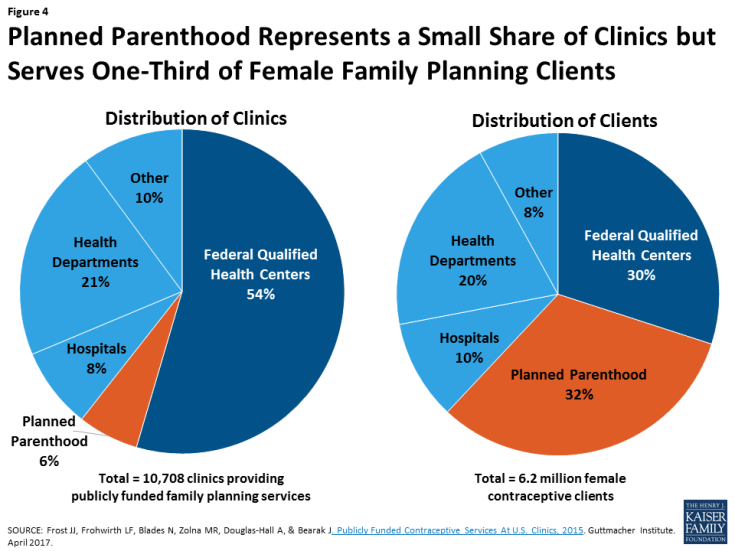
Figure 4: Planned Parenthood Represents a Small Share of Clinics but Serves One-Third of Female Family Planning Clients
Many States Have Already Enacted Laws To Block State Funding to Planned Parenthood Under Title X and Medicaid
The impact of banning federal Title X funds and Medicaid reimbursement to Planned Parenthood will vary across the country. In some states there are very few Planned Parenthood clinics, while in other states Planned Parenthood clinics are the predominant provider for patients seeking contraceptive services from publicly funded clinics (Figure 5). In 13 states, Planned Parenthood clinics were the site of care for over 40% of women who obtained publicly funded contraceptives.24 Experience has shown that blocking Planned Parenthood from receiving Medicaid reimbursements or Title X funding could reduce low-income women’s access to contraceptives. In 2013, Texas replaced its federally funded family planning waiver program with a 100% state funded program that excluded Planned Parenthood as a participating provider. Following the policy change, there was a sizable drop in Medicaid claims for LARC and injectable contraceptives and an increase in Medicaid-funded births.25 Similarly, in 2013 the Wisconsin legislature approved family planning cuts directed at Planned Parenthood, which resulted in the closure of five Planned Parenthood clinics in rural areas. Women who used the Planned Parenthood clinics were referred to other clinics that were usually further away, with waiting lists, and that did not provide the full range of contraceptive methods.26
Several other states have also attempted to exclude Planned Parenthood clinics from their Medicaid programs. However, currently this is in violation of Medicaid’s “any willing provider” requirement. In 2016, CMS clarified that “states may not deny qualification to family planning providers, or take other action against qualified family planning providers, that affects beneficiary access to those providers—whether individual providers, physician groups, outpatient clinics or hospitals—solely because they separately provide family planning services or the full range of legally permissible gynecological and obstetric care, including abortion services.”27 States have also taken other approaches to limiting or redirecting family planning funds to providers that do not offer abortion. Some states, such as New Jersey, have eliminated funding streams for family planning, while several others have blocked state and Title X funds to clinics that provide both family planning and abortion (Table 1). A few states, in contrast, have started to take action to assure that Planned Parenthood remains a viable option for women in their state. Maryland is the first state to enact legislation to reimburse Planned Parenthood for family planning services if federal funding is blocked, and Nevada and Connecticut have introduced similar legislation.28 However, as discussed earlier, the federal government pays 90% of family planning expenses under Medicaid, and states that opt to continue to pay for Medicaid services at Planned Parenthood would have to pick up the full cost of care for all services if a federal ban is enacted.
| Table 1: Selected State Policies and Legislative Proposals Regarding Public Funding for Family Planning Providers | |
| State Efforts to Limit or Protect Funding for Family Planning Providers | States |
| Bans certain family planning providers from receiving Medicaid funds (currently blocked by federal statute) | Alabama, Arizona, Arkansas, Florida, Illinois*, Indiana, Iowa*, Kansas, Louisiana, Michigan*, Mississippi, Missouri, New Hampshire, Ohio, Oklahoma, Pennsylvania*, Texas, Utah, Washington*, Wisconsin |
Prevents state family planning and/or Title X funds to:
.
.
|
Arizona, Arkansas, Colorado, Indiana, Kentucky, Michigan*, Ohio, Pennsylvania*, Texas, Washington*, Wisconsin
Kansas, Oklahoma
Arkansas, Colorado, Michigan, Ohio, Wisconsin |
| Prohibits other forms of public funds^ to abortion providers or entities affiliated with abortion provision or referral | Florida, Ohio, North Carolina |
| Directs state funds to reimburse Planned Parenthood for services if federal funding is blocked | Maryland, Nevada*, Connecticut* |
| NOTE: *Current bill introduced during the 2017 legislative session; ^Public funds from programs such as Breast and Cervical Cancer Mortality Prevention Act, Violence Against Women Act, HIV/AIDS initiatives, etc. SOURCE: Kaiser Family Foundation analysis of state legislation; Guttmacher Institute. State Family Planning Funding Restrictions. February 2017. |
|
Looking Forward
Despite efforts to exclude Planned Parenthood from receiving public funds, a majority (83%) of the public says it is important for the federal government to provide funding for reproductive health services, including family planning and birth control for lower-income women, and 75% say they support continued federal Medicaid funding to Planned Parenthood for non-abortion services (Figure 6).
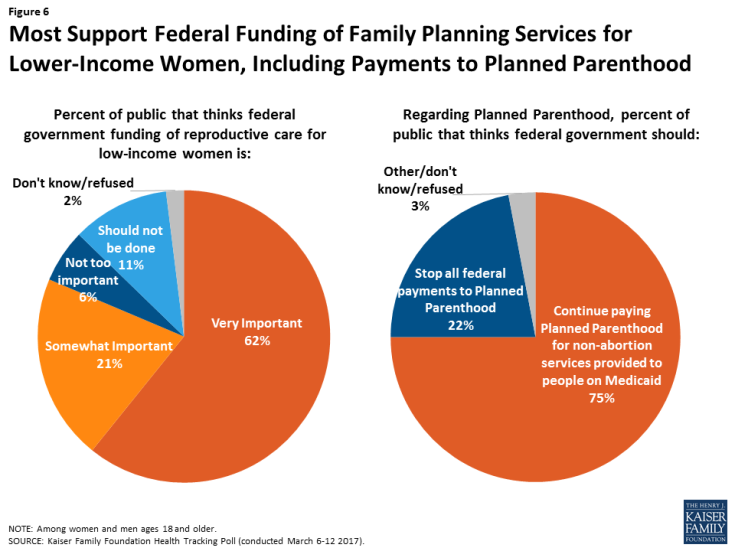
Figure 6: Most Support Federal Funding of Family Planning Services for Lower-Income Women, Including Payments to Planned Parenthood
Federal and state funding that supports Medicaid, the Title X program, and Section 330 of the PHSA is the financial core for safety-net clinics that provide family planning services to the uninsured and other vulnerable populations. The proposed changes to health care policy under Medicaid and Title X, as well as programmatic funding cuts currently being discussed at the federal level could have major repercussions for millions of low-income women that rely on these programs for their family planning care.
Endnotes
Jerman J, Jones RK & Onda T. Characteristics of U.S. Abortion Patients in 2014 and Changes Since 2008. Guttmacher Institute. 2016.
Finer LB & Zolna MR. (2016). Declines in Unintended Pregnancy in the United States, 2008-2011. The New England Journal of Medicine; 374(9):843–852.
Hasstedt, K, Sonfield A and Gold RB, Public Funding for Family Planning, Sterilization and Abortion Services, FY 1980–2015, New York: Guttmacher Institute, 2017.
Walls J, Gifford K, Ranji U, Salganicoff A, & Gomez I. Medicaid Coverage of Family Planning Benefits: Results from a State Survey. Kaiser Family Foundation. September 2016.
Coverage for abortions in other circumstances is only available in 15 states that use only state funds to pay for abortions.
Wachino V. (2016). Re: Clarifying “Free Choice of Provider” Requirement in Conjunction with State Authority to Take Action against Medicaid Providers. Centers for Medicare and Medicaid Services (CMS).
Fowler CI, Gable J, Wang J, & Lasater B. (2016). Family Planning Annual Report: 2015 national summary. RTI International.
Ibid.
Office of Population Affairs, Program Requirements for Title X Funded Family Planning Projects, April 2014.
Fowler CI, Gable J, Wang J, & Lasater B. (2016). Family Planning Annual Report: 2015 national summary. RTI International.
Wood S, Beeson T, Bruen B, Goetz Goldberg D, Mead K, Shin P, & Rosenbaum S. (2014). Scope of family planning services available in Federally Qualified Health Centers. Contraception; 89, pp. 85-90.
Ibid.
Zolna MR & Frost JJ. Publicly Funded Family Planning Clinics in 2015: Patterns and Trends in Service Delivery Practices and Protocols. Guttmacher Institute. November 2016.
Frost JJ, Benson Gold R, Frohwirth L, & Blades N. Variation in Service Delivery Practices Among Clinics Providing Publicly Funded Family Planning Services in 2010. Guttmacher Institute. May 2012.
Schmit C. Medicaid Service Delivery: Federally Qualified Health Centers. Centers for Medicare and Medicaid Services (CMS).
HRSA. What are Federally qualified health centers (FQHCs)?. Accessed January 2017.
HRSA Health Center Program. 2015 Health Center Data Snapshot. Accessed January 2017.
HRSA Health Center Program. Table 3A- Patients by Age and Gender. Accessed January 2017.
Heisler EJ. Federal Health Centers: An Overview. Congressional Research Service. January 2016.
Congressional Budget Office. (2017). American Health Care Act: Budget Reconciliation Recommendations of the House Committees on Ways and Means and Energy and Commerce, March 9, 2017.
Guttmacher Institute. (2016). Publicly Funded Family Planning Services in the United States. Rosenbaum, S. Can Community Health Centers Fill The Health Care Void Left By Defunding Planned Parenthood? Health Affairs, January 27, 2017.
Frost J., Frohwirth L, Blades N., Zolna M., Douglas-Hall, A., Bearak, J. Publicly Funded Contraceptive Services at U.S. Clinics, 2015. Guttmacher Institute. April 2017.
Stevenson AJ, Flores-Vazquez IM, Allgeyer RL, Schenkkan P, Potter JE. (2016). Effect of Removal of Planned Parenthood from the Texas Women’s Health Program. The New England Journal of Medicine; 374: 853-860.
Redden M. Healthcare without Planned Parenthood: Wisconsin and Texas Point to a Dark Future. The Guardian. January 17, 2017.
Centers for Medicaid and Medicare Services (CMS). (2016). Re: Clarifying “Free Choice of Provider” Requirement in Conjunction with State Authority to Take Action Against Medicaid Providers.
Health – Family Planning Services – Continuity of Care, HB1083, 2017 Maryland 437th Legislative Session.

